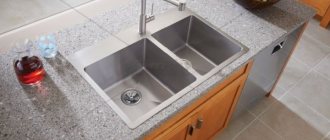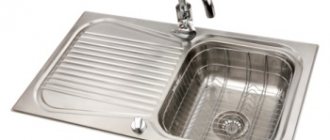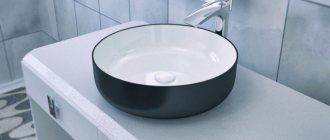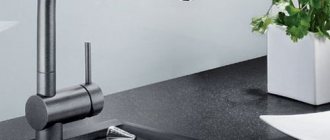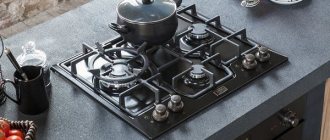Texture like marble chips of a kitchen sink
Stone-look sinks for the kitchen are often called “granite sinks,” although this is quite incorrect, since the manufacturing technology of such products only makes it possible to imitate any texture of the material (granite, marble, onyx), as well as colors and shapes. A distinctive feature of such plumbing equipment is the originality and exclusivity of the design, ranging from high-tech style to vintage.
Manufacturing sinks from artificial stone
These sinks are made by casting composite materials that contain a mineral base and a polymer binder. The mineral base is presented in the form of marble, granite chips, fiberglass and other materials that determine the color and texture of the product. The example in the photo of a kitchen sink made of artificial stone imitates a marble structure.
Using a binder polymer base (usually acrylic), the sink is given a shape. Thanks to its chemical composition, the equipment receives strength and excellent performance characteristics.
Reviews of stone kitchen sinks most often indicate their excellent resistance to aggressive cleaning agents, be it alcohol, kerosene, acids or alkalis - they do not damage the surfaces of the products.
Type of durable kitchen sink
The kitchen sink made of artificial stone in the photo shows equipment that has high mechanical strength, which is three times greater than that of natural stone. If even a very heavy object falls into the sink, it will not cause cracks, chips or other types of damage.
Such strength of kitchen sinks made of artificial stone, according to manufacturer reviews, is achieved thanks to modern technologies for polishing products.
Stone kitchen sink: pros and cons
Artificial stone sinks: composition, characteristics, advantages
dated February 19, 2014
The sink is perhaps one of the most important elements in every kitchen. It is used much more often than other kitchen appliances - microwaves, ovens, hoods, etc. Artificial stone sinks today are in higher demand than their metal counterparts. They are not only aesthetically pleasing, but also pleasant to the touch, easy to care for and, most importantly, do not make loud noise or noise while washing dishes.
Is it worth buying a sink made of artificial stone? If yes, which one should you choose? Before making a decision and moving directly to the choice, you should familiarize yourself with their characteristics and varieties in more detail.
Artificial stone sink: composition and main characteristics
Artificial stone for sinks is a composite consisting of filler and connecting elements. The filler is natural minerals, and binder polymers (resins) are used for the connection. The composition, as a rule, is as follows: 80% natural stone (crumbs of marble, granite) and 20% polymer binders . In addition, dyes are also introduced. Modern sinks made of artificial stone are coated with gelcoat - a special composition that increases the durability of the surface. This is a protective layer that makes the sink smooth and free of pores. This coating allows you to preserve its magnificent appearance for a long time.
Sinks made of artificial stone are cast products. The material from which they are made is also called “casting stone”. Vibratory casting technology allows you to cast sinks of any size, shape and degree of complexity.
The artificial stone from which kitchen sinks are made has specific properties and special characteristics. It is characterized by high reliability, homogeneous structure, and resistance to various chemicals.
Artificial stone sinks: colors, models, surface types
Modern technologies used in the manufacture of artificial stone sinks make it possible to obtain a huge number of different variations of colors, shades and textures. Sinks in white, black and beige colors, similar to natural stone with their pattern and rough surface, are in particular demand. However, the choice is much wider: on sale you can find products in green, pink, red, blue and other colors. The color of the sink is preserved even after 8-10 years of active use of the product.
When painting artificial stone sinks, various effects can be created: antique, shagreen, gloss, matte, silky-matte, etc. Many models of such products are made with a structured surface.
The design of artificial stone sinks is extremely diverse. After all, this is a molded product, which means it can be given absolutely any shape. The most popular are two-bowl sinks in the shape of a shell or butterfly. In general, the range of sinks made from composites is wider than those made from stainless steel.
Performance characteristics of sinks made of artificial stone
Kitchen sinks made from artificial stone are distinguished by excellent performance. They do not require frequent maintenance, are practically resistant to mechanical damage (with the exception of glossy surfaces, which can be scratched if handled incorrectly, for example, due to sharp objects), withstand critical temperatures (from -30 to +150 degrees), and They are also easy to clean from all kinds of contaminants.
An important feature of artificial stone is its extremely low coefficient of thermal expansion. This means that even with an instantaneous increase or decrease in temperature by several tens (or even hundreds) of degrees, the surface of the sink will not crack or deteriorate. For comparison: ceramic analogues can deteriorate when subjected to sudden heating or cooling - for example, when pouring boiling water into a cold sink. In such cases, metal products do not crack, but they may produce a loud cracking sound that resembles a muffled blow on an iron surface.
Kitchen sinks made of artificial stone are resistant to the negative effects of chemically aggressive substances. Numerous studies have shown that their condition and appearance do not deteriorate even after interaction with household reagents such as hydrochloric, phosphoric and perchloric acid, ammonia, hydrogen peroxide, iodine solution, silver nitrate and lead acetate. Only acetone and concentrated nitric acid can cause small marks to appear on sanded surfaces.
Artificial stone sink: pros and cons
Artificial stone has a number of unique properties that give products made from it not only an aesthetic appearance, but also excellent characteristics. In particular, this material has the following advantages:
- Durability of the working surface. As a rule, the service life of kitchen sinks made of artificial stone is at least 10 years. In this parameter, this material is slightly inferior to natural stone, but, at the same time, superior to ceramics. Manufacturers of composite sinks take the liberty of asserting that with proper use, the product can, if desired, be bequeathed to one’s grandchildren.
- Hygienic safety. Artificial stone, thanks to a special manufacturing technology, prevents the appearance of harmful bacteria and microorganisms in the sink. Accordingly, there is no bad smell from the sink. There is no unpleasant slimy coating on its surface. The composite is not a source of increased background radiation, which is often the problem with products made from natural stone.
- Huge margin of safety. According to various estimates, artificial stone is 2-3 times superior to natural stone in its mechanical strength. Interestingly, even concrete is inferior to it in this physical parameter. Thanks to this, kitchen sinks made of artificial stone are not damaged after quite heavy objects (iron utensils, kitchen appliances, etc.) fall on them.
- Possibility of complete restoration of geometry and surface when defects appear. In order to return the sink to its original appearance and clean it from scratches, potholes, etc., you just need to wipe the desired area with sandpaper and polish it. And accidentally broken pieces of artificial stone can be easily glued back using acrylic glue - and there will not even be a seam left from the adhesive composition in that place.
However, like any other material, artificial stone is not without some disadvantages. You cannot place excessively heated metal utensils (pots, pans, etc.) on its surface - for this you need to use special stands. Hot dishes just removed from the heat can leave a noticeable mark on the sink.
If you drop something really heavy on the sink, it may crack or chip. However, this happens extremely rarely and depends, among other things, on the quality of the wash.
More complaints are received about monolithic countertop sinks. This is a relatively new product in our kitchen components market. The artificial stone countertop is cast entirely along with the sink. It looks nice, of course. The advantage is the absence of “seams”. However, there is also a significant disadvantage: if the sink breaks, the entire structure will have to be replaced. Ironically or due to the peculiarities of the technology, it is monolithic sinks that are damaged more often than independent ones.
Sink made of artificial stone or stainless steel?
Artificial stone and stainless steel are perhaps the most popular materials for making kitchen sinks. The relatively low price, as well as many advantages, make them the best choice for buyers who cannot afford to purchase products made from natural stone.
Stainless steel sinks in most cases have a lower cost than their artificial stone counterparts. Stainless steel products go well with faucets and demonstrate good strength and durability. However, unlike sinks made of artificial stone, they have poor sound absorption, as a result of which they can make loud noise under the pressure of water. In addition, the stainless steel surface is less resistant to scratches, which, moreover, cannot be removed. Very quickly, a new stainless steel sink loses its original luster: many micro-scratches and deposits from minerals contained in the water make it dull and not very clean in appearance.
Which is better: a sink made of artificial stone or stainless steel?
A stainless steel sink requires more careful maintenance than an artificial stone sink. Stainless steel should be wiped dry after washing, otherwise unsightly stains will remain. This is not observed with composite sinks.
The advantage of a composite sink over a stainless steel product is the variability of colors. All stainless steel sinks have only one color - steel. This solution is not suitable for every kitchen. Among the artificial stone sinks there is a suitable option for any interior.
In some cases, a stainless steel sink will be preferable - for example, in a situation where the weight of the product is important. An artificial stone sink weighs much more.
Artificial stone sink: how to choose
First of all, pay attention to the shape of the sink. Rectangular options with one bowl are a classic. Such products are easy to install and usually have a spacious bowl. This is an excellent choice for those who wash dishes by hand.
For a large kitchen, a sink with two bowls and a “wet table” is perfect - its length should be at least 1 m. Two-bowl sinks are very convenient: you can defrost meat and wash dirty vegetables at the same time. Or wash dishes in one bowl, and soak vegetables and fruits in another before washing.
If you need to install additional faucets, it is not necessary to look for a product with holes for it. Artificial stone sinks can be drilled perfectly. To do this, you need to use a diamond-coated drill.
If you are afraid of plaque and water stains, choose a sink not of a single color, but with a pattern of stone or crumbs. A speckled product is easier to care for. Dirt and deposits are simply invisible.
The most important thing: buy a sink from a reputable manufacturer. Take your time. See who is the creator of the sink you like, and look for this company’s website on the Internet (all serious manufacturers of plumbing fixtures have their own websites). Reliable manufacturers mark their products, providing them with a technical passport and providing a warranty (usually 2 years from the date of purchase). The composition of an artificial stone sink from a well-known brand on the market will correspond to what is stated in the passport. Optimal composition: 80% filler and 20% binder polymers.
If you purchase a cheaper analogue from an unknown manufacturer, unpleasant surprises may await you soon after you start using it, including bending of the sink, deep chips, and even tearing off the bottom of the bowl.
See also:
Film facades: pros and cons, comparison with other options
Kitchen set in two colors
How to highlight the dining area? Dining room design in kitchen and living room
Pros and cons of sinks: artificial stone and stainless steel
The choice of sink when arranging a kitchen is extremely important. It should be beautiful, functional, comfortable and practical. It is desirable that it is easy to keep clean.
Modern housewives are offered various models from a wide variety of materials. There are high-quality ceramics, various types of artificial stone and stainless steel. What to choose?
Stainless steel kitchen sink
Professional commercial kitchens still use stainless steel equipment. Probably for the reason that this material easily withstands high operating loads.
Pros of a stainless sink
- Not afraid of sudden temperature changes. You can put hot pots and pans directly from the stove in the sink, pour boiling water, etc. The main thing is that the siphon and sewer pipes can withstand.
- Durable. Stainless steel is not afraid of impacts. You are not afraid that if a pan falls from the shelf, the sink will be damaged.
- Aesthetic. Easily fits into any color scheme of the room. Easily integrates into any design style. Looks great in tandem with modern household appliances.
- Resistant to aggressive household chemicals.
- Does not stain.
- Does not absorb pollutants.
- Forms a single surface with countertops and hobs made of identical material.
Cons of a stainless sink
- The glossy surface treacherously reveals the presence of tiny drops. Requires wiping dry after each use.
- Small scratches are noticeable, which inevitably form upon contact with the dishes. The matte satin model is already scratched enough for this flaw to be barely noticeable, but in this case you will have to give up the shiny gloss.
- If, when applying a strong detergent, you leave it in longer than expected, then dark spots will form on the surface that cannot be removed with anything, because. the surface decorative layer is damaged. The sink does not lose its functional qualities, but its aesthetic characteristics noticeably suffer.
- Metal containers are excellent resonators. The sound of falling water intensifies and spreads throughout the room. A small drip from the tap at night will prevent you from sleeping, but it will encourage you to repair the tap and reduce your water bills.
- It is impossible to paint the metal the same color as the countertop. High mechanical loads do not make it possible to apply painting or lamination. The metal appears in its natural beauty.
Kitchen sink made of acrylic artificial stone
Acrylic stone is made from polymer resins, mineral filler, dyes and hardeners. At the end of the technological process, the working surface is covered with a specialized protective coating, which reliably protects the sink from dirt.
Pros of acrylic stone
- Resistant to temperature changes. It is enough to remember how you took a contrast shower in an acrylic bath, and doubts about this property of the material will disappear.
- Withstands impacts. The introduction of fiberglass into the working mass and layers of non-woven material reliably reinforce the walls and bottom.
- Integrates perfectly with countertops and window sills made from an identical mixture.
- High aesthetic properties.
- Rich palette and textures.
- The ability to imitate natural materials from stone to wood.
- If damaged, craftsmen can restore the surface.
Cons of acrylic stone
- Does not tolerate contact with hot metal. On the wing of the sink, experienced craftsmen place special coasters for hot items. Acrylic, like any plastic, melts and turns black when exposed to the bottom of pots and pans that have just been removed from the heat.
- The scratches are clearly visible.
- High price.
Composite mineral-polymer stone
Composite sinks are made from a mixture of polymer resins and crushed natural stone. Fine mineral chips are made from granite, quartz or marble.
The higher the stone content, the less polymer base, and accordingly, the surface becomes more resistant to abrasion and scratches. At the same time, impact resistance decreases. Therefore, there is no universal recipe for all housewives. Those who do not have heavy dishes choose a high content of stone chips, and those who have doubts prefer a higher percentage of polymer binder.
Advantages of a composite sink
- Ideally imitates various types of natural stone.
- For small chips and scratches, you can sand and polish the damaged area, and the defect will be eliminated.
- Major damage can be repaired using the appropriate composition. To do this, you need to contact the workshop where the washing was done.
- Absorbs the sound of falling water.
- Fits perfectly into any interior thanks to a large selection of colors.
- High variability of forms.
- Withstands contact with hot objects.
Cons of composite sinks
- Natural stone cracks due to thermal shock. For this reason, damaged stones are not used in steam rooms. Therefore, it is undesirable to allow sudden changes in temperature.
- High price.
- Heavy weight. A permanent foundation is required.
How to choose the best sink? Useful tips!
- For a small family, a compact, small-sized sink is quite suitable. Otherwise, take a look at roomy models with two bowls. The number of bowls may vary. How much you need depends on what dishes and in what quantities you are preparing. For slicing, narrow small containers are provided in which vegetables and herbs can dry after a shower.
- The functionality of the model is of great importance. Modern designers think through everything down to the smallest detail. For small kitchens, sinks are produced with included cutting boards that can be installed on the sink bowl. This allows you to significantly increase the area of the cutting zone. Hanging screens help you quickly rinse pasta, rinse vegetables, and deal with cleanups.
- The installation height and bowl depth have a critical impact on the condition of your back. Deep models are convenient for large pans. When cutting, you will want the vegetables to be slightly higher. A compromise can be found in additional equipment or models with multi-level bowls. If there is enough space, you can install two independent mortise bowls.
- Stainless steel fits perfectly into modern interiors. The stone goes well with antiquity. Bronze maintains a retro style. Always consider the overall style of the kitchen when choosing plumbing fixtures. In this case, your home will not only delight your eyes, but also cause admiration among your guests.
- Inset sinks are good for countertops that are not afraid of moisture. The edges are treated with waterproofing materials. Overlay models are great for sets in which the cabinets have an individual work surface and can be rearranged as you please. In mini-kitchens, multi-surfaces that combine a domino hob and a sink perfectly solve the problem of lack of space.
- Equipment. Pay close attention to the siphon included in the kit. Straight models can lead to disruption of the water seal, which can lead to the appearance of unpleasant odors in the kitchen. This part can always be replaced with a more acceptable one. All you have to do is go to a plumbing store.
Before deciding to purchase a specific model, it is useful to have a clear kitchen plan in advance, know the dimensions of the lower cabinets, and also have a list of the functions that the sink should perform. In this case, you will purchase exactly the model that will be your faithful assistant in your culinary creativity.
Nov 14, 2020 Werri
Granite kitchen sink: pros and cons
Kitchen renovation ends with the installation of plumbing, and here the question arises: which sink to choose - stainless or granite - reviews about them are quite contradictory. A product made of natural or artificial stone can recoup its cost many times over; we will talk about the pros and cons of such sinks in this article.
Granite kitchen sinks are incredibly durable
Kitchen sinks are made from natural and artificial stone. Natural material is very expensive and difficult to work with. The price of such plumbing fixtures is high, so they are practically not used in mass production. Bowls made from stone chips and adhesive polymer are offered to the general consumer. Sometimes a dye is included in the composition.
Granite kitchen sinks: pros and cons
Advantages of kitchen sanitary ware made of stone:
- They are incredibly resistant to external influences. Aggressive chemistry, shock, boiling water and ice have virtually no effect.
- Silence is an argument for those who do not like the sound of falling water. Granite dampens the impact of the jet.
- The material from which such plumbing fixtures are made is considered safe and environmentally friendly. It does not absorb odors and is not susceptible to plaque formation.
- Easy to clean - just wipe the bowl with soapy water and rinse. It will shine with pristine purity for many years.
- Wide range of colors, shapes and models. You can choose a model to suit any needs and dimensions.
However, despite all the positive qualities, granite kitchen sinks have some disadvantages:
- The main disadvantage is the high cost. Depending on the manufacturer, size and material, it can reach several tens of thousands.
- Cheap and, accordingly, low-quality products are too fragile.
- Heavy weight and difficult to install.
Certain disadvantages of stone plumbing are obvious, but the pros far outweigh the cons.
The best granite sinks: which one to choose?
If you decide that you want a sink made of artificial stone, the question arises of choosing a manufacturer. You should pay attention to the middle price segment. In this case, the optimal combination of “price” and “quality” parameters is optimal.
- German siligranite sinks;
- – German manufacturer of crystallight products;
- The French make sanitary ware from ceramate and novoquartz.
These are just the most popular manufacturers. New sellers are constantly appearing on the market, and perhaps their products will be better.
A sink made of artificial quartz or granite is the choice of practical owners. It will serve your family for many years and will recoup its cost many times over.
“Network publication “WomansDay.ru (WomansDey.ru)” Certificate of registration of mass media EL No. FS77-67790, issued by the Federal Service for Supervision of Communications, Information Technologies and Mass Communications (Roskomnadzor) December 13, 2020 16+. Copyright (c) Hirst Shkulev Publishing LLC. 2020. Any reproduction of site materials without the permission of the editors is prohibited. Contact information for government agencies (including Roskomnadzor):
- Kitchens "Mebelkomplekt" Country of origin: Russia. Catalog of models KindSunnyExoticComfortableModernAffableNobleAmenableAristocratic RichHospitableJuicyKindTraditionalGentleColorfulAiryBright
- Kitchens Grattarola Country of origin: Italy. Catalog of models UraliaCanardCeresium CeresiumEssenziaAxisUllaUraliaAxisEssenziaTundraCeresiumUralia
- Kitchens Antares Country of origin: Italy. Catalog of models OperaOperaOperaOperaPetraToscaToscaOperaOperaOperaOperaBrio PetraPetraPetraPetraSistemaSistemaPetraToscaSistema Sistema
- Kitchens Cesar Country of origin: Italy. Catalog of models YaraYaraMegMegArielArielElleElitLuceGioElitLuceYaraMayaMaya MayaMayaYara VipMayaFridaYaraYaraLuceArielMegArielArielElleFridaYara GioElitYaraFridaGioYaraYara
Advantages of kitchen sinks made of artificial stone
If we compare this type of product with stainless steel sinks, the following advantages of composite materials are obvious:
- A more attractive appearance, as seen in the photo of stone kitchen sinks, combined with practicality.
- A huge range of shapes, colors, sizes that can satisfy the most demanding customer needs.
- The noiselessness of such plumbing equipment.
- Strength characteristics.
- Easy selection of kitchen sinks made of artificial stone from photos to any room interior or countertops.
Disadvantages of artificial stone kitchen equipment
Compared to stainless steel products, this type of sink has a number of disadvantages:
- Significantly higher cost.
- Due to its impressive weight, such equipment is more difficult to transport and install.
- Reviews of a stone kitchen sink indicate that if aggressive dyes come into contact with its surface, it becomes stained, that is, urgent cleaning of the product is recommended.
- It is better not to install the sink yourself, but to entrust it to professionals.
What are the disadvantages
Finishing and renovation
- Floor coverings
- Parquet, parquet board
- Laminate
- Linoleum
- Self-leveling floors
- Cork floor
- Carpets
- Ceramic tiles and porcelain tiles
- Doors
- Entrance doors
- Interior doors
- Metal doors
- Entrance groups
- Window
- Balcony frames
- PVC windows
- Wooden windows
- Walls, interior decoration
- Wallpaper
- Photo wallpaper
- Decorative plaster
- Paint and varnish products
- Stretch ceiling
mag.dom.by
Do not place dishes in quartz sinks that have just been removed from the burner. Contact with hot material from a pot or pan may leave a mark on the surface of the sink. In this property, stainless steel outperforms composite.
The surface of many quartz kitchen sinks is coated with a special gelcoat-based compound. As a result, a decorative protective layer is formed on the product, which can be easily washed off from dirt with a soft sponge and ordinary detergents.
The sink cannot be cleaned with metal brushes or abrasive powders due to the high probability of damage to the surface. For some users, such restrictions are a significant disadvantage; they are used to scrubbing the sink with scourers made of metal threads.
For many buyers, the most important factor characterizing a product is price. For quartz sinks it is rather large, which is a disadvantage for a large number of potential owners, so they choose stainless steel.
The desire to buy is strengthened by the opportunity to use a beautiful, original sink. It will serve for many years without losing its attractiveness.
READ MORE: How to choose a sheep's wool blanket
Installing a heavy sink requires the participation of several specialists. If the product has a non-standard shape or size, then diamond cutters will be needed for installation. The process may take several hours, but the result will be enjoyable every day.
Composite kitchen sinks are not without some disadvantages; they have both pros and cons, so manufacturers and experienced users warn about the specifics of their use.
Instructions for caring for a stone sink
A wide range of artificial stone sinks
In order to maintain the aesthetic appearance of an artificial stone kitchen sink, as in the photo above, daily care is necessary. The principle of maintenance is to wipe the surface of the product with a sponge and apply any dishwashing detergent.
If limescale appears on the sink, use household chemicals specialized for this purpose or ordinary vinegar. Buyers in reviews of artificial stone kitchen sinks advise wiping the product dry after use to prevent deposits of various origins.
Principles for choosing artificial stone kitchen sinks
Today, the plumbing equipment market is represented by many manufacturers, whose catalogs contain various photos of stone kitchen sinks. Products differ in model range, price and specially developed compositions of materials. Some manufacturers add Teflon to the composite composition to repel dirt from the surface of the sink or triclosan with silver ions to protect against germs and bacteria.
The choice of a stone sink for the kitchen in most cases comes down to the aesthetic preferences of the buyer, that is, how the product fits into the design of the room, as well as financial capabilities. The price of a sink depends on its quality and manufacturer. The highest class is famous for its good material composition and the presence of protective coatings. Cheaper models “sacrifice quality.” So the selection consists of determining the optimal price-quality ratio.
In the video you can watch a test of stone shells for mechanical damage:
What else to pay attention to
So, you have decided for yourself which sink is better - steel, stone or ceramic. Now let's talk about other criteria that should be taken into account when choosing.
For convenience, we will simply list a number of tips that will help you choose the best quality and most suitable model:
- Sinks made of natural stone require careful care, are afraid of acids, absorb some pigments and odors, and are also very expensive and difficult to install;
- A copper or aluminum sink is too soft and will quickly become covered with scratches and other mechanical damage;
- You should think in advance what type of faucet you want to see on your sink and select a model taking into account the method of its installation;
- Equally important is the way the sink is installed on the countertop. There are overhead, mortise and integrated models, this must be taken into account in advance;
- Think about which bowl shape will be most convenient for you. Now models with two and three bowls are becoming popular, it is also important to think about depth;
- Modern products are often equipped with auxiliary accessories - dryers, colanders, cutting boards, etc. Choose the set that suits you best;
- Please pay attention to the installation method of the product. The instructions for self-installation should be clear and feasible for you.
Interesting articles:
- Kitchen sink - 120 photos in modern design
- How to embed a sink into a countertop - do it yourself, instructions, video
- Building a house from SIP panels: pros and cons; features; can you do it yourself?
- Bathtubs made of cast marble 83 photos, pros and cons of marble models, reviews of bathtubs made of cast artificial marble
